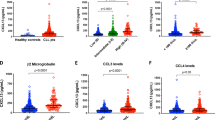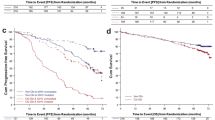Abstract
SPC2996 is a novel locked nucleic acid phosphorothioate antisense molecule targeting the mRNA of the Bcl-2 oncoprotein. We investigated the mechanism of action of SPC2996 and the basis for its clinically observed immunostimulatory effects in chronic lymphocytic leukemia (CLL). Patients with relapsed CLL were treated with a maximum of six doses of SPC2996 (0.2–6 mg/kg) in a multicenter phase I trial. Microarray-based transcriptional profiling of circulating CLL cells was carried out before and after the first infusion of SPC2996 in 18 patients. Statistically significant transcriptomic changes were observed at doses ⩾4 mg/kg and occurred as early as 24 h after the first infusion of the oligonucleotide. SPC2996 induced the upregulation of 466 genes including a large number of immune response and apoptotic regulator molecules, which were enriched for Toll-like receptor response genes. Serum measurements confirmed the release of pro-inflammatory cytokines including chemokine (C–C motif) ligand 3 (macrophage inflammatory protein 1α) and tumor necrosis factor-α, thereby validating the in vivo transcriptomic data at the protein level. SPC2996 caused a ⩾50% reduction of circulating lymphocytes in five of 18 (28%) patients, which was found to be independent of its immunostimulatory and anti-Bcl-2 effects.
This is a preview of subscription content, access via your institution
Access options
Subscribe to this journal
Receive 12 print issues and online access
$259.00 per year
only $21.58 per issue
Buy this article
- Purchase on Springer Link
- Instant access to full article PDF
Prices may be subject to local taxes which are calculated during checkout





Similar content being viewed by others
References
Hallek M, Cheson BD, Catovsky D, Caligaris-Cappio F, Dighiero G, Dohner H et al. Guidelines for the diagnosis and treatment of chronic lymphocytic leukemia: a report from the International Workshop on Chronic Lymphocytic Leukemia updating the National Cancer Institute—Working Group 1996 guidelines. Blood 2008; 111: 5446–5456.
Schimmer AD, Munk-Pedersen I, Minden MD, Reed JC . Bcl-2 and apoptosis in chronic lymphocytic leukemia. Curr Treat Opt Oncol 2003; 4: 211–218.
Chanan-Khan A . Bcl-2 antisense therapy in B-cell malignancies. Blood Rev 2005; 19: 213–221.
Cheson BD . Oblimersen for the treatment of patients with chronic lymphocytic leukemia. Ther Clin Risk Manag 2007; 3: 855–870.
O’Brien S, Moore JO, Boyd TE, Larratt LM, Skotnicki A, Koziner B et al. Randomized phase III trial of fludarabine plus cyclophosphamide with or without oblimersen sodium (Bcl-2 antisense) in patients with relapsed or refractory chronic lymphocytic leukemia. J Clin Oncol 2007; 25: 1114–1120.
O’Brien S, Moore JO, Boyd TE, Larratt LM, Skotnicki AB, Koziner B et al. 5-year survival in patients with relapsed or refractory chronic lymphocytic leukemia in a randomized, phase III trial of fludarabine plus cyclophosphamide with or without oblimersen. J Clin Oncol 2009; 27: 5208–5212.
O’Brien SM, Cunningham CC, Golenkov AK, Turkina AG, Novick SC, Rai KR . Phase I to II multicenter study of oblimersen sodium, a Bcl-2 antisense oligonucleotide, in patients with advanced chronic lymphocytic leukemia. J Clin Oncol 2005; 23: 7697–7702.
Kim R, Emi M, Matsuura K, Tanabe K . Antisense and nonantisense effects of antisense Bcl-2 on multiple roles of Bcl-2 as a chemosensitizer in cancer therapy. Cancer Gene Ther 2007; 14: 1–11.
O’Connor OA, Smith EA, Toner LE, Teruya-Feldstein J, Frankel S, Rolfe M et al. The combination of the proteasome inhibitor bortezomib and the bcl-2 antisense molecule oblimersen sensitizes human B-cell lymphomas to cyclophosphamide. Clin Cancer Res 2006; 12: 2902–2911.
Vollmer J, Jepsen JS, Uhlmann E, Schetter C, Jurk M, Wader T et al. Modulation of CpG oligodeoxynucleotide-mediated immune stimulation by locked nucleic acid (LNA). Oligonucleotides 2004; 14: 23–31.
Stein CA, Hansen JB, Lai J, Wu S, Voskresenskiy A, Hog A et al. Efficient gene silencing by delivery of locked nucleic acid antisense oligonucleotides, unassisted by transfection reagents. Nucleic Acids Res 2010; 38: e3.
Veedu RN, Wengel J . Locked nucleic acid as a novel class of therapeutic agents. RNA Biol 2009; 6: 321–323.
Stein CA, Hansen JB, Lai J, Wu S, Voskresenskiy A, Hog A et al. Efficient gene silencing by delivery of locked nucleic acid antisense oligonucleotides, unassisted by transfection reagents. Nucleic Acids Res 2010; 38: e3.
Hüttmann A, Klein-Hitpass L, Thomale J, Deenen R, Carpinteiro A, Nückel H et al. Gene expression signatures separate B-cell chronic lymphocytic leukaemia prognostic subgroups defined by ZAP-70 and CD38 expression status. Leukemia 2006; 20: 1774–1782.
Seiffert M, Stilgenbauer S, Döhner H, Lichter P . Efficient nucleofection of primary human B cells and B-CLL cells induces apoptosis, which depends on the microenvironment and on the structure of transfected nucleic acids. Leukemia 2007; 21: 1977–1983.
Cheson BD, Bennett JM, Grever M, Kay N, Keating MJ, O’Brien S et al. National Cancer Institute-sponsored Working Group guidelines for chronic lymphocytic leukemia: revised guidelines for diagnosis and treatment. Blood 1996; 87: 4990–4997.
Jahrsdörfer B, Jox R, Muhlenhoff L, Tschoep K, Krug A, Rothenfusser S et al. Modulation of malignant B cell activation and apoptosis by bcl-2 antisense ODN and immunostimulatory CpG ODN. J Leukoc Biol 2002; 72: 83–92.
Friedberg JW, Kelly JL, Neuberg D, Peterson DR, Kutok JL, Salloum R et al. Phase II study of a TLR-9 agonist (1018 ISS) with rituximab in patients with relapsed or refractory follicular lymphoma. Br J Haematol 2009; 146: 282–291.
Huggins J, Pellegrin T, Felgar RE, Wei C, Brown M, Zheng B et al. CpG DNA activation and plasma-cell differentiation of CD27-naive human B cells. Blood 2007; 109: 1611–1619.
Chu VT, Enghard P, Riemekasten G, Berek C . In vitro and in vivo activation induces BAFF and APRIL expression in B cells. J Immunol 2007; 179: 5947–5957.
Capolunghi F, Cascioli S, Giorda E, Rosado MM, Plebani A, Auriti C et al. CpG drives human transitional B cells to terminal differentiation and production of natural antibodies. J Immunol 2008; 180: 800–808.
Burczynski ME, Twine NC, Dukart G, Marshall B, Hidalgo M, Stadler WM et al. Transcriptional profiles in peripheral blood mononuclear cells prognostic of clinical outcomes in patients with advanced renal cell carcinoma. Clin Cancer Res 2005; 11: 1181–1189.
Cresta S, Sessa C, Catapano CV, Gallerani E, Passalacqua D, Rinaldi A et al. Phase I study of bortezomib with weekly paclitaxel in patients with advanced solid tumours. Eur J Cancer 2008; 44: 1829–1834.
Rosenwald A, Chuang EY, Davis RE, Wiestner A, Alizadeh AA, Arthur DC et al. Fludarabine treatment of patients with chronic lymphocytic leukemia induces a p53-dependent gene expression response. Blood 2004; 104: 1428–1434.
Kruhoffer M, Dyrskjot L, Voss T, Lindberg RL, Wyrich R, Thykjaer T et al. Isolation of microarray-grade total RNA, microRNA, and DNA from a single PAXgene blood RNA tube. J Mol Diagn 2007; 9: 452–458.
Jahrsdorfer B, Hartmann G, Racila E, Jackson W, Muhlenhoff L, Meinhardt G et al. CpG DNA increases primary malignant B cell expression of costimulatory molecules and target antigens. J Leukoc Biol 2001; 69: 81–88.
Jahrsdörfer B, Wooldridge JE, Blackwell SE, Taylor CM, Griffith TS, Link BK et al. Immunostimulatory oligodeoxynucleotides induce apoptosis of B cell chronic lymphocytic leukemia cells. J Leukocyte Biol 2005; 77: 378–387.
Gekeler V, Gimmnich P, Hofmann HP, Grebe C, Rommele M, Leja A et al. G3139 and other CpG-containing immunostimulatory phosphorothioate oligodeoxynucleotides are potent suppressors of the growth of human tumor xenografts in nude mice. Oligonucleotides 2006; 16: 83–93.
Muzio M, Scielzo C, Bertilaccio MT, Frenquelli M, Ghia P, Caligaris-Cappio F . Expression and function of toll like receptors in chronic lymphocytic leukaemia cells. Br J Haematol 2009; 144: 507–516.
Rozkova D, Novotna L, Pytlik R, Hochova I, Kozak T, Bartunkova J et al. Toll-like receptors on B-CLL cells: expression and functional consequences of their stimulation. Int J Cancer 2010; 126: 1132–1143.
Spaner DE, Shi Y, White D, Shaha S, He L, Masellis A et al. A phase I/II trial of TLR-7 agonist immunotherapy in chronic lymphocytic leukemia. Leukemia 2010; 24: 222–226.
Nowak AK, Lake RA, Marzo AL, Scott B, Heath WR, Collins EJ et al. Induction of tumor cell apoptosis in vivo increases tumor antigen cross-presentation, cross-priming rather than cross-tolerizing host tumor-specific CD8T cells. J Immunol 2003; 170: 4905–4913.
Dürig J, Ebeling P, Grabellus F, Sorg UR, Möllmann M, Schütt P et al. A novel nonobese diabetic/severe combined immunodeficient xenograft model for chronic lymphocytic leukemia reflects important clinical characteristics of the disease. Cancer Res 2007; 67: 8653–8661.
Acknowledgements
We thank Anja Führer and Sabrina Kieruzel for excellent technical assistance.
Author contributions
JD, UD, MW, JBRH, HØ designed research; JD, LK-H, JW performed research; JD, UD, MW, JBH, HØ, LK-H analyzed and interpreted data; and JD, LK-H and MW wrote the paper.
Author information
Authors and Affiliations
Corresponding author
Ethics declarations
Competing interests
JD received research funding from and is a scientific advisor to Santaris (Copenhagen, DK). LK-H is scientific advisor to Santaris and received financial compensation. JW, JBH, HØ and MW are employees of Santaris Pharma. UD declares no potential conflict of interest.
Additional information
Supplementary Information accompanies the paper on the Leukemia website
Rights and permissions
About this article
Cite this article
Dürig, J., Dührsen, U., Klein-Hitpass, L. et al. The novel antisense Bcl-2 inhibitor SPC2996 causes rapid leukemic cell clearance and immune activation in chronic lymphocytic leukemia. Leukemia 25, 638–647 (2011). https://doi.org/10.1038/leu.2010.322
Received:
Revised:
Accepted:
Published:
Issue Date:
DOI: https://doi.org/10.1038/leu.2010.322
Keywords
This article is cited by
-
Emerging role of long non-coding RNAs in cancer chemoresistance: unravelling the multifaceted role and prospective therapeutic targeting
Molecular Biology Reports (2020)
-
Progress in RNAi-mediated Molecular Therapy of Acute and Chronic Myeloid Leukemia
Molecular Therapy - Nucleic Acids (2015)
-
Aurora kinases in childhood acute leukemia: the promise of aurora B as therapeutic target
Leukemia (2013)
-
Therapeutic advancement of chronic lymphocytic leukemia
Journal of Hematology & Oncology (2012)



